
An aerial drone photo taken on July 17, 2024 shows stilted buildings in Tianmen Village, Shuicheng District of Liupanshui, southwest China's Guizhou Province. In the hinterland of Wumeng Mountain and by the Beipanjiang River, quaint stilted buildings scatter among the green mountains and waters, forming a pastoral picture, in Tianman Village.
Tianmen Village is located in the northeast of Huajia Miao, Buyi and Yi Township of Liupanshui City, which is a traditional Buyi ethnic village, divided into 6 hamlets with a population of more than 1,000.
Surrounded by mountains on three sides and a river on the other, the remote village was once isolated. To get out of the village, people had to climb hundreds of stone stairs over the steep mountain and pass through cliffs in the canyon.
Tianmen Village has a history of more than 600 years, and still retains 178 buildings made of wood shingles. The original landscape of the village and traditional folk activities have become a major feature for the village, which are also the focus of cultural protection and tourism promotion. (Xinhua/Tao Liang)

Villagers are pictured at a stilted building in Tianmen Village, Shuicheng District of Liupanshui, southwest China's Guizhou Province, July 16, 2024. In the hinterland of Wumeng Mountain and by the Beipanjiang River, quaint stilted buildings scatter among the green mountains and waters, forming a pastoral picture, in Tianman Village.
Tianmen Village is located in the northeast of Huajia Miao Buyi and Yi Township of Liupanshui City, which is a traditional Buyi ethnic village, divided into 6 hamlets with a population of more than 1,000.
Surrounded by mountains on three sides and a river on the other, the remote village was once isolated. To get out of the village, people had to climb hundreds of stone stairs over the steep mountain and pass through cliffs in the canyon.
Tianmen Village has a history of more than 600 years, and still retains 178 buildings made of wood shingles. The original landscape of the village and traditional folk activities have become a major feature for the village, which are also the focus of cultural protection and tourism promotion. (Xinhua/Tao Liang)

Villager Lu Shengxiu (1st R) smiles as she attends a social gathering in Tianmen Village, Shuicheng District of Liupanshui, southwest China's Guizhou Province, July 16, 2024. In the hinterland of Wumeng Mountain and by the Beipanjiang River, quaint stilted buildings scatter among the green mountains and waters, forming a pastoral picture, in Tianman Village.
Tianmen Village is located in the northeast of Huajia Miao Buyi and Yi Township of Liupanshui City, which is a traditional Buyi ethnic village, divided into 6 hamlets with a population of more than 1,000.
Surrounded by mountains on three sides and a river on the other, the remote village was once isolated. To get out of the village, people had to climb hundreds of stone stairs over the steep mountain and pass through cliffs in the canyon.
Tianmen Village has a history of more than 600 years, and still retains 178 buildings made of wood shingles. The original landscape of the village and traditional folk activities have become a major feature for the village, which are also the focus of cultural protection and tourism promotion. (Xinhua/Tao Liang)
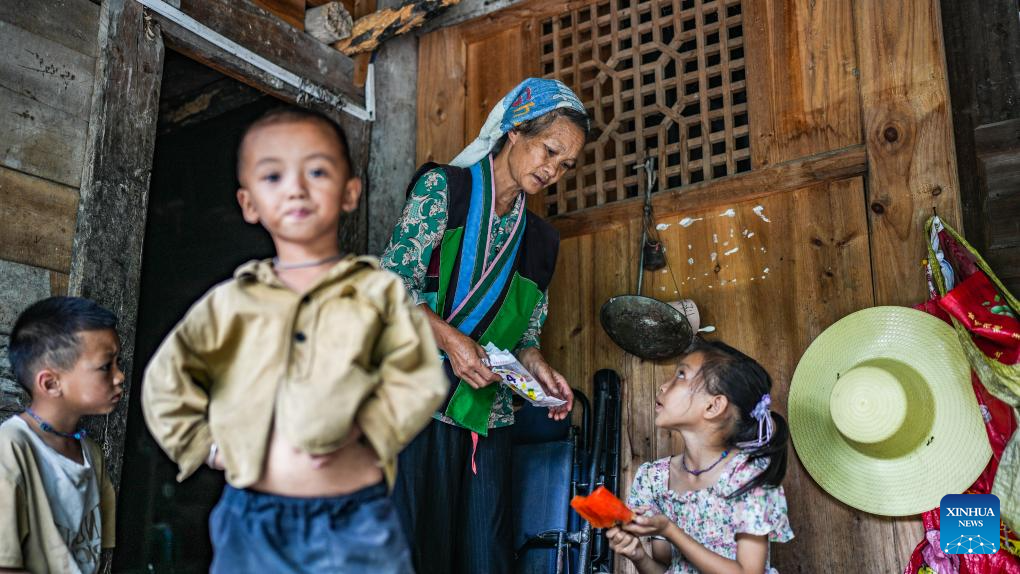
Villager Lu Feng distributes popsicles to her grandchildren in Tianmen Village, Shuicheng District of Liupanshui, southwest China's Guizhou Province, July 16, 2024. In the hinterland of Wumeng Mountain and by the Beipanjiang River, quaint stilted buildings scatter among the green mountains and waters, forming a pastoral picture, in Tianman Village.
Tianmen Village is located in the northeast of Huajia Miao Buyi and Yi Township of Liupanshui City, which is a traditional Buyi ethnic village, divided into 6 hamlets with a population of more than 1,000.
Surrounded by mountains on three sides and a river on the other, the remote village was once isolated. To get out of the village, people had to climb hundreds of stone stairs over the steep mountain and pass through cliffs in the canyon.
Tianmen Village has a history of more than 600 years, and still retains 178 buildings made of wood shingles. The original landscape of the village and traditional folk activities have become a major feature for the village, which are also the focus of cultural protection and tourism promotion. (Xinhua/Tao Liang)

An aerial drone photo taken on July 17, 2024 shows a view of Tianmen Village, Shuicheng District of Liupanshui, southwest China's Guizhou Province. In the hinterland of Wumeng Mountain and by the Beipanjiang River, quaint stilted buildings scatter among the green mountains and waters, forming a pastoral picture, in Tianman Village.
Tianmen Village is located in the northeast of Huajia Miao Buyi and Yi Township of Liupanshui City, which is a traditional Buyi ethnic village, divided into 6 hamlets with a population of more than 1,000.
Surrounded by mountains on three sides and a river on the other, the remote village was once isolated. To get out of the village, people had to climb hundreds of stone stairs over the steep mountain and pass through cliffs in the canyon.
Tianmen Village has a history of more than 600 years, and still retains 178 buildings made of wood shingles. The original landscape of the village and traditional folk activities have become a major feature for the village, which are also the focus of cultural protection and tourism promotion. (Xinhua/Tao Liang)
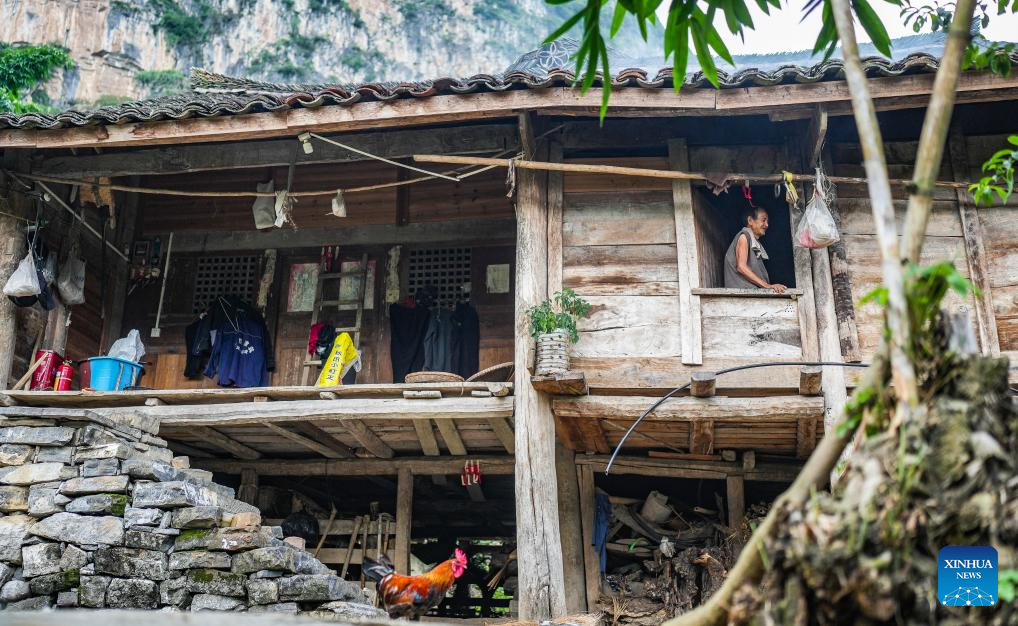
Villager Lu Guoshi rests at a stilted building in Tianmen Village, Shuicheng District of Liupanshui, southwest China's Guizhou Province, July 16, 2024. In the hinterland of Wumeng Mountain and by the Beipanjiang River, quaint stilted buildings scatter among the green mountains and waters, forming a pastoral picture, in Tianman Village.
Tianmen Village is located in the northeast of Huajia Miao Buyi and Yi Township of Liupanshui City, which is a traditional Buyi ethnic village, divided into 6 hamlets with a population of more than 1,000.
Surrounded by mountains on three sides and a river on the other, the remote village was once isolated. To get out of the village, people had to climb hundreds of stone stairs over the steep mountain and pass through cliffs in the canyon.
Tianmen Village has a history of more than 600 years, and still retains 178 buildings made of wood shingles. The original landscape of the village and traditional folk activities have become a major feature for the village, which are also the focus of cultural protection and tourism promotion. (Xinhua/Tao Liang)
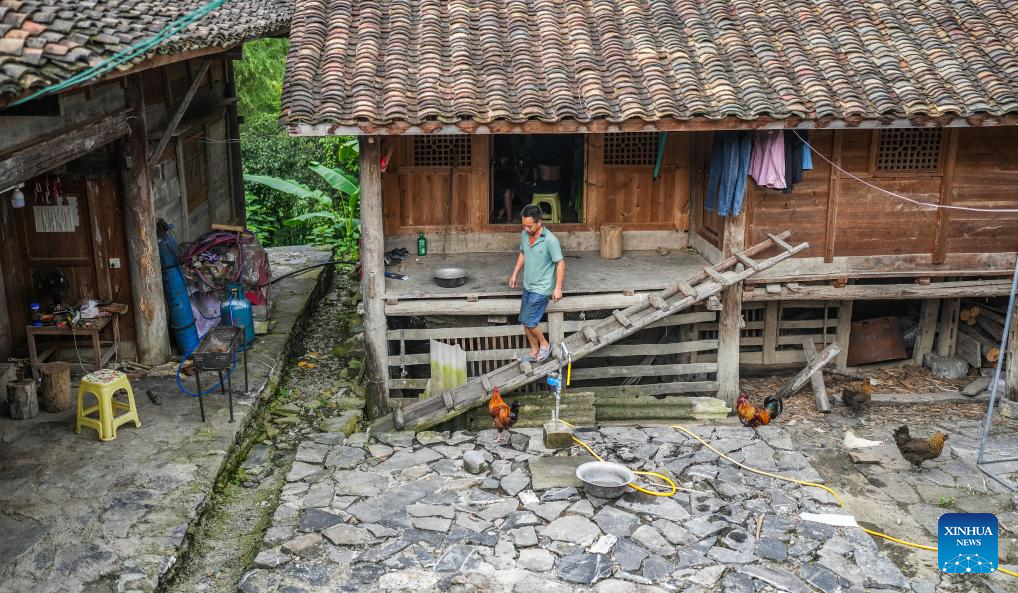
Villager Wang Shihong walks downstairs from a stilted building in Tianmen Village, Shuicheng District of Liupanshui, southwest China's Guizhou Province, July 17, 2024. In the hinterland of Wumeng Mountain and by the Beipanjiang River, quaint stilted buildings scatter among the green mountains and waters, forming a pastoral picture, in Tianman Village.
Tianmen Village is located in the northeast of Huajia Miao Buyi and Yi Township of Liupanshui City, which is a traditional Buyi ethnic village, divided into 6 hamlets with a population of more than 1,000.
Surrounded by mountains on three sides and a river on the other, the remote village was once isolated. To get out of the village, people had to climb hundreds of stone stairs over the steep mountain and pass through cliffs in the canyon.
Tianmen Village has a history of more than 600 years, and still retains 178 buildings made of wood shingles. The original landscape of the village and traditional folk activities have become a major feature for the village, which are also the focus of cultural protection and tourism promotion. (Xinhua/Tao Liang)

An aerial drone photo taken on July 17, 2024 shows stilted buildings in Tianmen Village, Shuicheng District of Liupanshui, southwest China's Guizhou Province. In the hinterland of Wumeng Mountain and by the Beipanjiang River, quaint stilted buildings scatter among the green mountains and waters, forming a pastoral picture, in Tianman Village.
Tianmen Village is located in the northeast of Huajia Miao Buyi and Yi Township of Liupanshui City, which is a traditional Buyi ethnic village, divided into 6 hamlets with a population of more than 1,000.
Surrounded by mountains on three sides and a river on the other, the remote village was once isolated. To get out of the village, people had to climb hundreds of stone stairs over the steep mountain and pass through cliffs in the canyon.
Tianmen Village has a history of more than 600 years, and still retains 178 buildings made of wood shingles. The original landscape of the village and traditional folk activities have become a major feature for the village, which are also the focus of cultural protection and tourism promotion. (Xinhua/Tao Liang)

A child pats a dog in Tianmen Village, Shuicheng District of Liupanshui, southwest China's Guizhou Province, July 16, 2024. In the hinterland of Wumeng Mountain and by the Beipanjiang River, quaint stilted buildings scatter among the green mountains and waters, forming a pastoral picture, in Tianman Village.
Tianmen Village is located in the northeast of Huajia Miao Buyi and Yi Township of Liupanshui City, which is a traditional Buyi ethnic village, divided into 6 hamlets with a population of more than 1,000.
Surrounded by mountains on three sides and a river on the other, the remote village was once isolated. To get out of the village, people had to climb hundreds of stone stairs over the steep mountain and pass through cliffs in the canyon.
Tianmen Village has a history of more than 600 years, and still retains 178 buildings made of wood shingles. The original landscape of the village and traditional folk activities have become a major feature for the village, which are also the focus of cultural protection and tourism promotion. (Xinhua/Tao Liang)
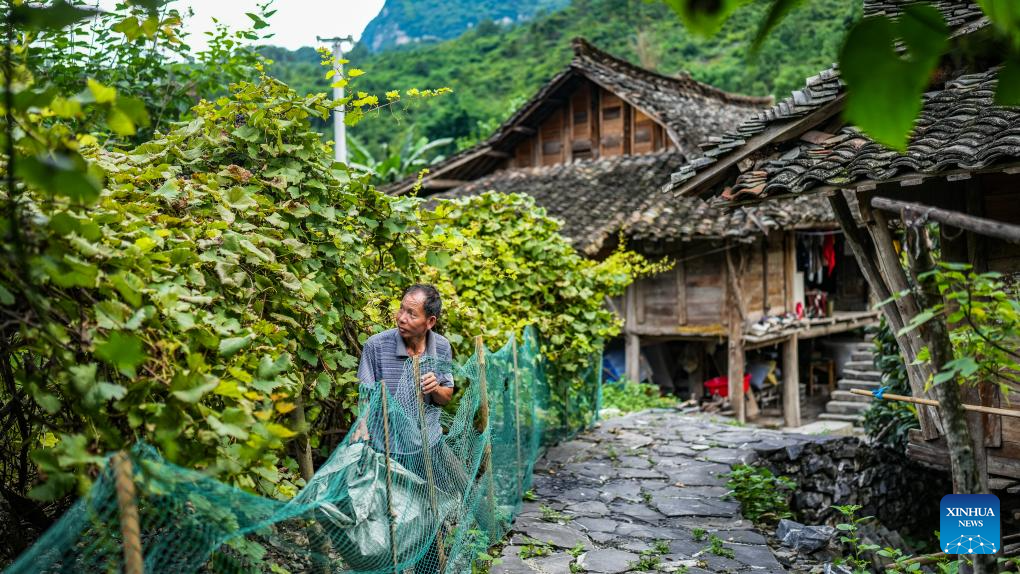
Villager Wang Hualong prepares to harvest grapes in Tianmen Village, Shuicheng District of Liupanshui, southwest China's Guizhou Province, July 16, 2024. In the hinterland of Wumeng Mountain and by the Beipanjiang River, quaint stilted buildings scatter among the green mountains and waters, forming a pastoral picture, in Tianman Village.
Tianmen Village is located in the northeast of Huajia Miao Buyi and Yi Township of Liupanshui City, which is a traditional Buyi ethnic village, divided into 6 hamlets with a population of more than 1,000.
Surrounded by mountains on three sides and a river on the other, the remote village was once isolated. To get out of the village, people had to climb hundreds of stone stairs over the steep mountain and pass through cliffs in the canyon.
Tianmen Village has a history of more than 600 years, and still retains 178 buildings made of wood shingles. The original landscape of the village and traditional folk activities have become a major feature for the village, which are also the focus of cultural protection and tourism promotion. (Xinhua/Tao Liang)
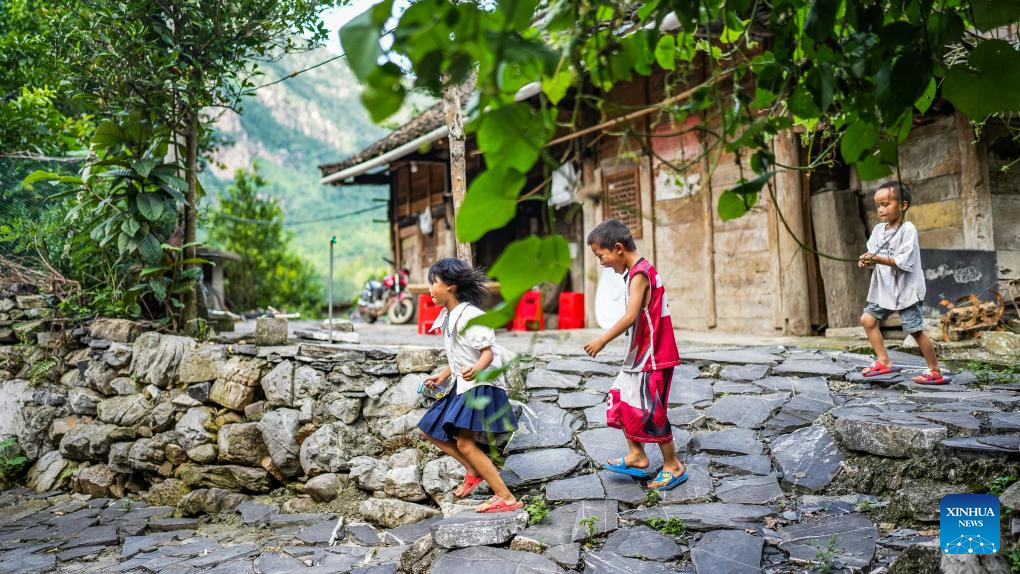
Children pass a stone slate paved road in Tianmen Village, Shuicheng District of Liupanshui, southwest China's Guizhou Province, July 16, 2024. In the hinterland of Wumeng Mountain and by the Beipanjiang River, quaint stilted buildings scatter among the green mountains and waters, forming a pastoral picture, in Tianman Village.
Tianmen Village is located in the northeast of Huajia Miao Buyi and Yi Township of Liupanshui City, which is a traditional Buyi ethnic village, divided into 6 hamlets with a population of more than 1,000.
Surrounded by mountains on three sides and a river on the other, the remote village was once isolated. To get out of the village, people had to climb hundreds of stone stairs over the steep mountain and pass through cliffs in the canyon.
Tianmen Village has a history of more than 600 years, and still retains 178 buildings made of wood shingles. The original landscape of the village and traditional folk activities have become a major feature for the village, which are also the focus of cultural protection and tourism promotion. (Xinhua/Tao Liang)
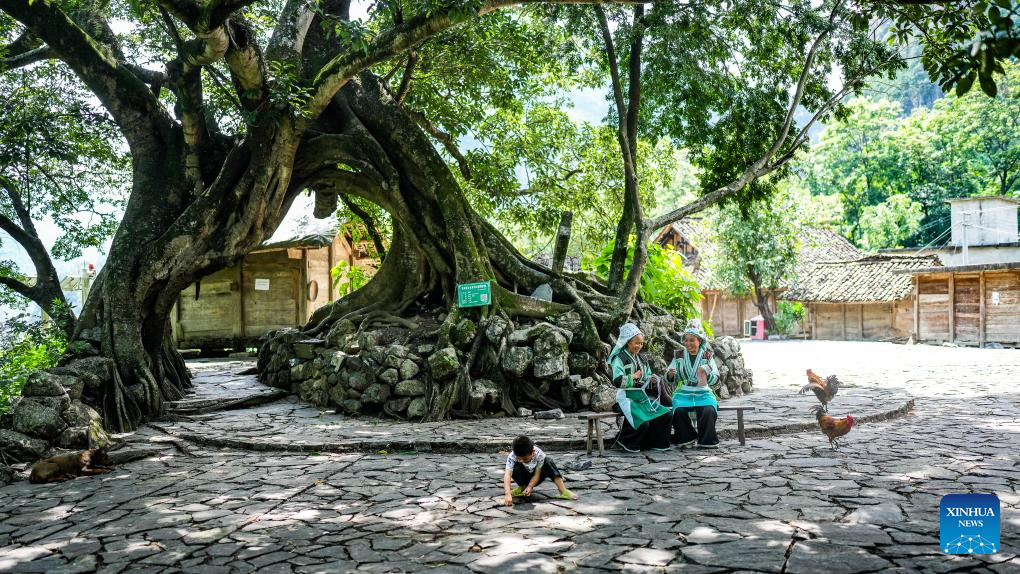
Villagers Wang Gangliang (C) and Wang Shixi (R) make embroidery works under a tree in Tianmen Village, Shuicheng District of Liupanshui, southwest China's Guizhou Province, July 16, 2024. In the hinterland of Wumeng Mountain and by the Beipanjiang River, quaint stilted buildings scatter among the green mountains and waters, forming a pastoral picture, in Tianman Village.
Tianmen Village is located in the northeast of Huajia Miao Buyi and Yi Township of Liupanshui City, which is a traditional Buyi ethnic village, divided into 6 hamlets with a population of more than 1,000.
Surrounded by mountains on three sides and a river on the other, the remote village was once isolated. To get out of the village, people had to climb hundreds of stone stairs over the steep mountain and pass through cliffs in the canyon.
Tianmen Village has a history of more than 600 years, and still retains 178 buildings made of wood shingles. The original landscape of the village and traditional folk activities have become a major feature for the village, which are also the focus of cultural protection and tourism promotion. (Xinhua/Tao Liang)
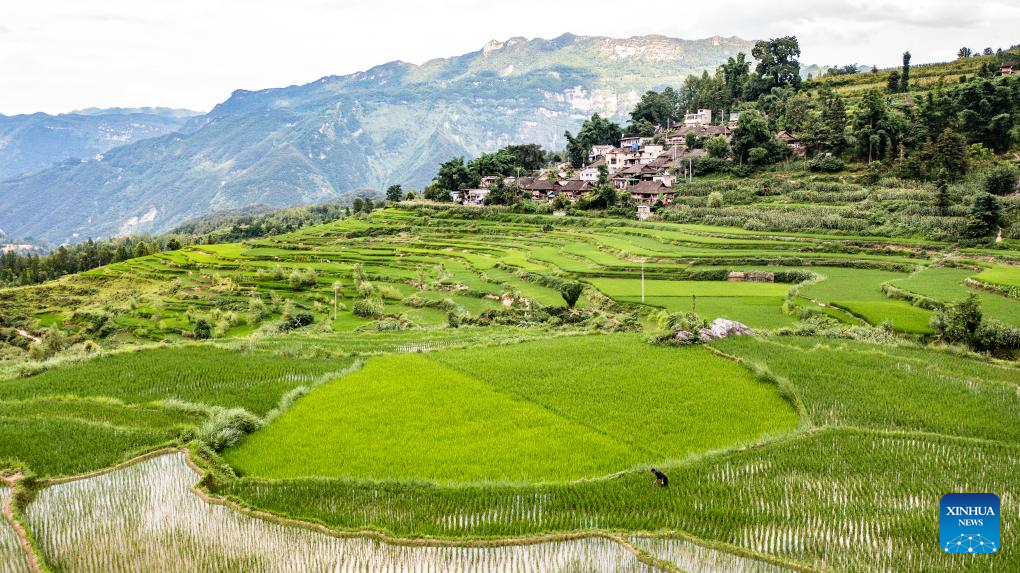
An aerial drone photo taken on July 16, 2024 shows a view of Tianmen Village, Shuicheng District of Liupanshui, southwest China's Guizhou Province. In the hinterland of Wumeng Mountain and by the Beipanjiang River, quaint stilted buildings scatter among the green mountains and waters, forming a pastoral picture, in Tianman Village.
Tianmen Village is located in the northeast of Huajia Miao Buyi and Yi Township of Liupanshui City, which is a traditional Buyi ethnic village, divided into 6 hamlets with a population of more than 1,000.
Surrounded by mountains on three sides and a river on the other, the remote village was once isolated. To get out of the village, people had to climb hundreds of stone stairs over the steep mountain and pass through cliffs in the canyon.
Tianmen Village has a history of more than 600 years, and still retains 178 buildings made of wood shingles. The original landscape of the village and traditional folk activities have become a major feature for the village, which are also the focus of cultural protection and tourism promotion. (Xinhua/Tao Liang)
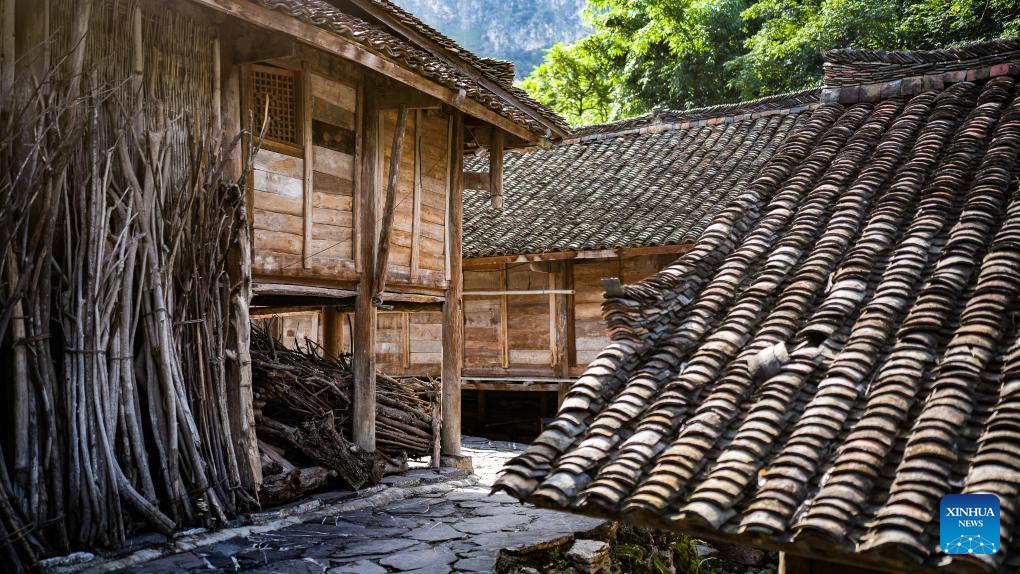
This photo taken on July 16, 2024 shows stilted buildings made of wood shingles in Tianmen Village, Shuicheng District of Liupanshui, southwest China's Guizhou Province. In the hinterland of Wumeng Mountain and by the Beipanjiang River, quaint stilted buildings scatter among the green mountains and waters, forming a pastoral picture, in Tianman Village.
Tianmen Village is located in the northeast of Huajia Miao Buyi and Yi Township of Liupanshui City, which is a traditional Buyi ethnic village, divided into 6 hamlets with a population of more than 1,000.
Surrounded by mountains on three sides and a river on the other, the remote village was once isolated. To get out of the village, people had to climb hundreds of stone stairs over the steep mountain and pass through cliffs in the canyon.
Tianmen Village has a history of more than 600 years, and still retains 178 buildings made of wood shingles. The original landscape of the village and traditional folk activities have become a major feature for the village, which are also the focus of cultural protection and tourism promotion. (Xinhua/Tao Liang)

Villager Lu Fenglin (2nd L) makes embroidery works under a tree in Tianmen Village, Shuicheng District of Liupanshui, southwest China's Guizhou Province, July 17, 2024. In the hinterland of Wumeng Mountain and by the Beipanjiang River, quaint stilted buildings scatter among the green mountains and waters, forming a pastoral picture, in Tianman Village.
Tianmen Village is located in the northeast of Huajia Miao Buyi and Yi Township of Liupanshui City, which is a traditional Buyi ethnic village, divided into 6 hamlets with a population of more than 1,000.
Surrounded by mountains on three sides and a river on the other, the remote village was once isolated. To get out of the village, people had to climb hundreds of stone stairs over the steep mountain and pass through cliffs in the canyon.
Tianmen Village has a history of more than 600 years, and still retains 178 buildings made of wood shingles. The original landscape of the village and traditional folk activities have become a major feature for the village, which are also the focus of cultural protection and tourism promotion. (Xinhua/Tao Liang)

Villagers Lu Dazhen (L) and Wang Xingzhen make embroidery works at a stilted building in Tianmen Village, Shuicheng District of Liupanshui, southwest China's Guizhou Province, July 16, 2024. In the hinterland of Wumeng Mountain and by the Beipanjiang River, quaint stilted buildings scatter among the green mountains and waters, forming a pastoral picture, in Tianman Village.
Tianmen Village is located in the northeast of Huajia Miao Buyi and Yi Township of Liupanshui City, which is a traditional Buyi ethnic village, divided into 6 hamlets with a population of more than 1,000.
Surrounded by mountains on three sides and a river on the other, the remote village was once isolated. To get out of the village, people had to climb hundreds of stone stairs over the steep mountain and pass through cliffs in the canyon.
Tianmen Village has a history of more than 600 years, and still retains 178 buildings made of wood shingles. The original landscape of the village and traditional folk activities have become a major feature for the village, which are also the focus of cultural protection and tourism promotion. (Xinhua/Tao Liang)

An aerial drone photo taken on July 17, 2024 shows a view of Tianmen Village, Shuicheng District of Liupanshui, southwest China's Guizhou Province. In the hinterland of Wumeng Mountain and by the Beipanjiang River, quaint stilted buildings scatter among the green mountains and waters, forming a pastoral picture, in Tianman Village.
Tianmen Village is located in the northeast of Huajia Miao Buyi and Yi Township of Liupanshui City, which is a traditional Buyi ethnic village, divided into 6 hamlets with a population of more than 1,000.
Surrounded by mountains on three sides and a river on the other, the remote village was once isolated. To get out of the village, people had to climb hundreds of stone stairs over the steep mountain and pass through cliffs in the canyon.
Tianmen Village has a history of more than 600 years, and still retains 178 buildings made of wood shingles. The original landscape of the village and traditional folk activities have become a major feature for the village, which are also the focus of cultural protection and tourism promotion. (Xinhua/Tao Liang)

Villager Lu Fengxuan releases himself from farm work as he unloads by his stilted building in Tianmen Village, Shuicheng District of Liupanshui, southwest China's Guizhou Province, July 16, 2024. In the hinterland of Wumeng Mountain and by the Beipanjiang River, quaint stilted buildings scatter among the green mountains and waters, forming a pastoral picture, in Tianman Village.
Tianmen Village is located in the northeast of Huajia Miao Buyi and Yi Township of Liupanshui City, which is a traditional Buyi ethnic village, divided into 6 hamlets with a population of more than 1,000.
Surrounded by mountains on three sides and a river on the other, the remote village was once isolated. To get out of the village, people had to climb hundreds of stone stairs over the steep mountain and pass through cliffs in the canyon.
Tianmen Village has a history of more than 600 years, and still retains 178 buildings made of wood shingles. The original landscape of the village and traditional folk activities have become a major feature for the village, which are also the focus of cultural protection and tourism promotion. (Xinhua/Tao Liang)



